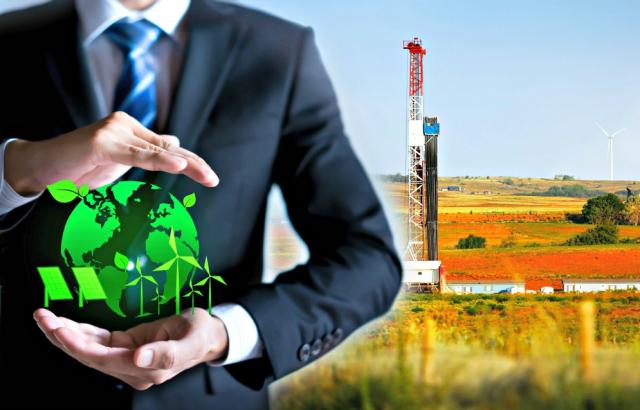
Investors have more recently begun to see climate change as a financial issue, said Andrew Logan, senior director of oil and gas for nonprofit group Ceres. (Source: Hart Energy/Shutterstock.com)
[Editor's note: A version of this story appears in the June 2019 edition of Oil and Gas Investor. Subscribe to the magazine here.]
In early 2018, Royal Dutch Shell Plc became the owner of Impello Ltd., including U.K. utility First Utility, and the first major oil and gas company to offer broadband internet service.
Overnight this year, the new business unit, Shell Energy Retail Ltd., also switched 700,000 British households to 100% renewable electricity. In 2019, the company intends to roll out a range of smart home offerings, including thermostats and electric vehicle (EV) charging.
Majors have tinkered, from time to time, with new technologies or made bets through investments that, in retrospect, seem far afield of their main business lines. Examples include metals, coal, butter and meat-processing.
Investors have raised questions about climate change for decades. But, more recently, investors have begun to see climate change as a financial issue, said Andrew Logan, senior director, oil and gas, for Ceres, a nonprofit that works with more than 160 institutional investors that manage $26 trillion in assets.
“There’s been a pretty dramatic ramping up in interest and concern in the past couple of years,” he said.
Pockets of energy investors may be focused more narrowly on water or proppant. “But I would say there is a sort of base level of concern over climate change and what it means for the long-term financial health of the industry that is pretty universal, at least among the investors we work with.”
Since 2018, majors and large independents have taken a more deliberate approach to investment in renewable energy. Companies such Shell, BP Plc, France’s Total SA and U.S. independent Occidental Petroleum Corp. acquired or entered partnerships in solar power generation, wind farms, and EV battery companies and infrastructure.
“Within the sector, we’ve seen plenty of evidence over the past 18 months of more focus on that sort of green space,” said Richard Taylor, a London-based oil and gas analyst for Fitch Solutions. “Shell, for example, at the beginning of last year, invested in Silicon Ranch [Corp., a Tennessee-based] solar company.”
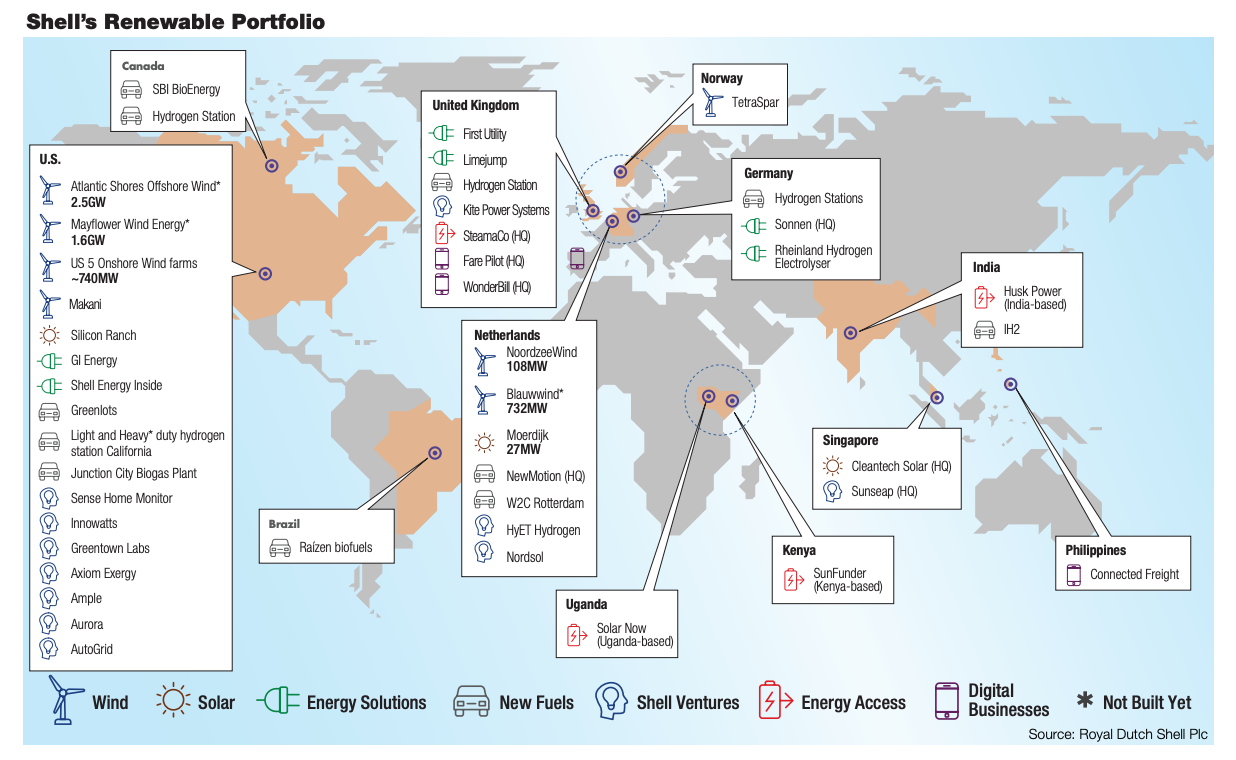
Shell is lauded by investor groups and analysts as a leader among oil and gas producers that are making room in their portfolios for green energy solutions. Since 2016, when Shell created its business line New Energies, the company has opened a comfortable lead over its rivals.
Others have followed with similar approaches. As of first-quarter 2019, Total said April 26 its new integrated gas, renewables and power segment would spearhead its and low-carbon electricity production.

senior director of oil
and gas for Ceres,
said producers
are following
paths that tend to
be “as lean and
low-carbon as
[they] can while
remaining oil and
gas companies.”
Shell is also earmarking up to $2 billion a year to buy into a buffet of renewable energy and alternative fuel companies, Taylor said. In relation to total capex, the annual spend is proportionately low, he added; in 2018, Shell’s capex was nearly $25 billion.
“There’s definitely been growth in this area,” he said. “And there’s also been a shift in the rhetoric, more broadly, in the reporting of these companies to now acknowledging these investments and how they’re important, even if small.”
In addition to purchasing a 44% stake in Silicon Ranch, Shell more recently purchased Sonnen, Europe’s largest maker of lithium-ion battery packs, and a California-based EV charging company. In California, it is working to build hydrogen filling stations.
Early on, Shell recognized the energy transition won’t be made through a single energy source, said Jason Klein, Shell vice president for U.S. energy transitions strategy. Rather, the transition to new types of energy will occur at differing rates across the globe.
“Right now, in New Energies, I’d say we’re mining for value, and we’re making modest investments across the entire value chain to figure out where Shell [can] make the most contributions and get the best return,” Klein said.
“So, we are looking at investments that offer end-to-end solutions. We’ve got investments in solar and wind, batteries, demand management and demand response.”
Since 2010, 24 of the largest oil and gas producers invested $22 billion on alternative energies, according to a November 2018 report by CDP, an advocacy group that represents more than 525 investors with $96 trillion in assets. Major oil and gas capex was expected to account for 1.3% of spending in 2018.
However, some majors—particularly Shell and Total—have upped spending and taken a hard look at power generation. Shell has said it will invest an average $1- to $2 billion annually through the end of the decade on new renewable power sources.
“We’ve been making investments across the entire power side—on the generation side,” Klein said.
Power Plans
Last July, Total closed on a majority stake in French electric company Direct Energie for about $1.6 billion. Shell has set its sights on adding power generation as the “fourth pillar” of its business alongside oil, gas and chemicals, according to Bernstein Research analyst Oswald Clint.
“Gobbling up rivals in the power sector is relatively cheap when armed with an oil company’s gigantic balance sheet,” Andy Critchlow, S&P Global Platts head of Europe, Middle East and Africa news, wrote in a March report.
In 2018, Shell’s annual net income was $23.9 billion. By contrast, Florida-based NextEra Energy Inc., one of the world’s largest renewable energy producers, generated about $16.7 billion in total revenue and net income of $6.6 billion.
In the U.S., Shell has become a leading player in the clean power market with its trading position. Shell manages 10 gigawatts in the U.S. with roughly a third produced by renewable energy sources, Clint wrote.
The company sees the electricity business changing radically during the next 25 years and wants to be a leader in providing that power. Klein said, “Certainly, we see power as part of the huge part of the puzzle going forward.
“We believe we can be the largest electric company by 2030. Here in the U.S., we’re unique in that the U.S. has multiple different market models in different parts of the country to see what works for different customers.”
In Europe, Shell has made a series of investments beginning in October of 2017 with NewMotion, an Amsterdam-based provider of smart-charging solutions for homes, businesses and vehicles. The company has added electricity storage and its U.K. electricity provider, Shell Energy.
“They’re now hoping to link those investments into providing services for European-centric customers,” Fitch’s Taylor said. “I assume the plan is to spread that business model across the globe.”
BP has entered EV charging with the June 2018 acquisition of Chargemaster, U.K.’s leading EV-charging infrastructure firm, Taylor said.
The U.S. is a key market, as well, because a segment of the U.S. population is also clamoring for cleaner energy solutions, Shell’s Klein said. “The somewhat unique thing about the U.S. is this really is being driven from the bottom, by and large,” he said.
“We’re seeing a growing interest at the consumer level and also seeing it at large businesses, particularly consumer-facing businesses that want to decarbonize themselves and their logistics chains for their customers,” he said.
While state and local governments are upping their approach to renewable power, “it isn’t being driven by governments mandating things as much as it is being driven by consumers and business.”
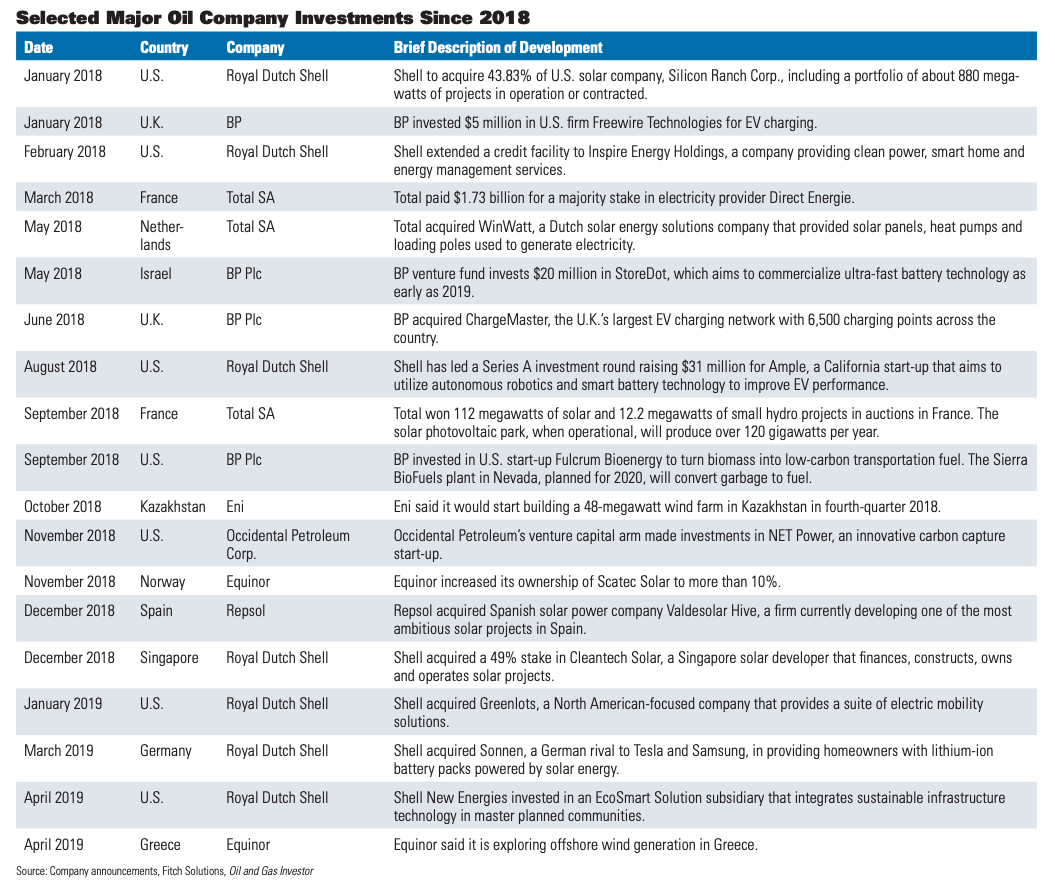
Silicon Ranch, having about 880 megawatts of power generation, is working on providing 102.5 megawatts of power for Facebook’s data center in Georgia. Mayflower Wind Energy LLC won a U.S. wind-lease auction offshore Massachusetts with a $135-million bid. Mayflower is a joint venture of EDPR Offshore North America LLC and Shell Energies US LLC.
Klein said electrification will be the fastest-growing trend in energy as the world works to meet the climate goals of the 2016 Paris Agreement.
“The power market is going to grow faster than any other market because the best way to decarbonize a developed economy such as [the U.S.] is to move as much stuff to electricity as possible and move as much as possible of the grid to renewable. We’re seeing that take hold already.”
Refueling
When chemist Elliot Berman started to pursue an idea for a new type of solar cell a half-century ago, a chance conversation led him to what was then known as Exxon Corp. His work there resulted in reducing the price of solar cells to $20 per watt from $100 in the early 1970s.
In the past few years, major oil and gas companies have chased new technologies, some with more zeal that others and, at times, with a less than clear plan on how to integrate new energy into existing portfolios.
“We’ve also taken our first move into solar,” Equinor ASA CEO Eldar Sætre said at IHS Markit’s CERAWeek in March. “We don’t know exactly how to do it. But it’s too big to ignore, so we include that as part of our strategy going forward.”
Equinor, which changed its name from Statoil last year, has been at the forefront of offshore wind in the U.K., Poland, Norway and more recently, New York and Massachusetts.
“We’re a pretty big payer when it comes to offshore wind,” Sætre said. “That plays into our skills.”
The company is also exploring floating offshore wind platforms, which Sætre said has a much bigger potential globally for capturing wind resources in deeper waters. In April, the company said it was also exploring floating wind generation offshore Greece.
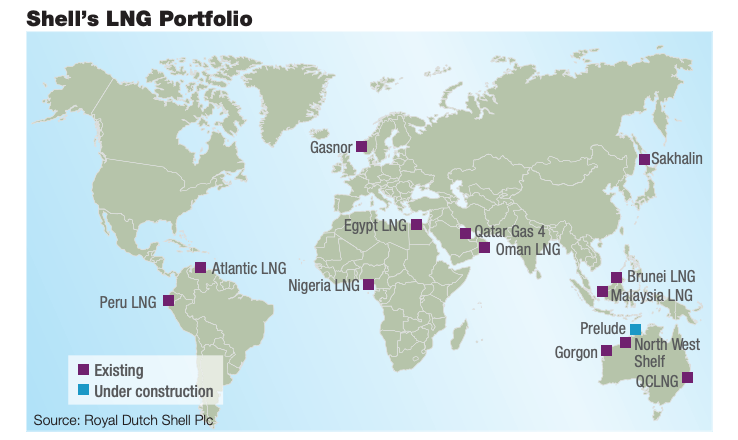
ExxonMobil Corp. is less directly investing in renewable energy since its work in the 1970s with solar cells. The company has sought wind and solar power for its Permian Basin operations from other providers and reached 12-year power-purchase agreements in late 2018.
The Irving, Texas-based major is spending to research advanced biofuels and algae with a goal of producing 10,000 barrels per day by 2025. An ExxonMobil spokesman said the company wasn’t able to comment for this article.
BP is taking a more cautious approach than Shell or Total. Partly, that’s because the company has been hampered by liabilities associated with the Deepwater Horizon oil spill, Ceres’ Logan said.

oil and gas analyst
for Fitch Solutions,
said shareholder
“rebellions” have
been seen across
the wider
energy space
through this year.
“In the last year or so, you see them making interesting investments in solar, batteries and EV charging,” he said. “It’s really cherry picking what they see as opportunities to grow a new business on the clean energy side of the house. Where they’re going to go in the future is a little less clear.”
Two years ago, BP invested $200 million in Lightsource, one of Europe’s largest solar development companies. By 2018, Lightsource’s reach extended to Brazil, India, Australia and six U.S. states.
And, in April, BP announced it would incentivize about 36,000 of its employees by tying an annual cash bonus to the company’s emissions-reduction targets. This follows Shell’s announcement that it would tie executive compensation to its climate goals.
BP has also said it would integrate the climate goals of the Paris Agreement into how it spends money, Logan said.
Shell’s Klein said the variety of Shell’s investments is a bit like putting pieces of a puzzle together to find the best solution for customers in a specific market. “It will vary country to country. But I think we’re making a lot of investments here in the U.S. in particular to try to find out where is the value for Shell in the chain.
“At the end of the day, we believe the customer end of the market is going to be the most interesting where Shell can add the most value and earn the best return.”
Shell created New Energies as a separate business line alongside its upstream and downstream businesses. New Energies is hinged on how to make a transition to a low-carbon energy future to manage the risks of climate change, while also producing more as an industry “to extend the benefits of energy to everyone on the planet,” Klein said.
“Since that time, we’ve made quite a few investments across the spectrum of new fuels and power-related businesses.”
The major is exploring alternative fuels, including hydrogen, “which has a real big role to play in the long term as a clean, high-density, liquid fuel,” Klein said.
In California, Shell is working with carmakers Honda Motor Co. Ltd. and Toyota Motor Corp. to build the infrastructure to supply their vehicles’ hydrogen fuel cells. Shell is also working with the Port of Long Beach for heavy-vehicle hydrogen fueling.
Shell already operates hydrogen-power stations in the state, with nine more in development for both heavy-duty and light-duty vehicles.
“To make hydrogen work as a clean energy solution, you have to solve this chicken-and-the-egg problem,” Klein said. “You need a vehicle manufacturer, and a fueling infrastructure provider and some government support for the technology to be aligned. And, right now, that’s happening in California.”
The company also purchased Greenlots, a Los Angeles-based company, in January. Greenlots provides EV charging and energy management software, including grid management services. It has deployed projects in 13 countries.
With its March acquisition of Germany’s Sonnen, Shell has also invested in household and small business batteries to help manage intermittency. “What we’re trying to do is find offerings that work for everybody,” Klein said.
“For a lot of people in light passenger vehicles, it might end up being EVs, so we’re working on EV charging infrastructure and providing renewable power through that.”
While the goal and focus are clear, renewable energy is not yet streamlined. Wind and solar are susceptible to intermittency—darkness and calm air—which will make power systems more complex.
“The energy transition isn’t going to happen overnight,” Klein said. “We need to rewire the entire global economy, which is just a huge undertaking.”
The bridge to get there, he said, is natural gas, “which is why we continue to invest in gas, and LNG and our traditional portfolio alongside our New Energies investments.”
Bridges And Bunkers
Nearly three years have passed since BG Group and Shell finalized their $53-billion merger. At the time, Tudor, Pickering, Holt & Co. analysts said Shell was making a conscious decision to pull back from U.S. shale and “stick to its strengths—deep water [and] LNG.”
Klein said, “Today, one in five LNG shipments in the world belongs to Shell.”
The investments offer an opportunity to take advantage of prolific shale resources. Among other projects, Shell and partner Energy Transfer LP are developing a large-scale LNG export facility in Lake Charles, La. It is also purchasing LNG from Cheniere Energy Inc.
“We see a significant role for U.S. LNG,” Klein said.
In December, Shell supplied fuel to the first LNG-fueled cruise ship, owned by Carnival Corp.
The company already engages in LNG bunkering in Europe and is building an LNG bunker barge to transport LNG from the Elba Island facility in Savannah, Ga., to Carnival ships in Florida. And it remains on the global hunt for areas where demand for lower-carbon solutions is most acute. Shell’s strategic advantage includes its brand, its trading business and the size of its retail footprint.
“We serve 30 million customers around the world [each day],” Klein said. “We have one of the biggest retail footprints on the planet.”
But until batteries and other storage systems are capable of servicing people’s needs, natural gas offers an advantaged, low-carbon emission fuel source, he said.
The company also sees a role for gas to chemicals and is investing billions of dollars in its Pennsylvania chemicals project, “which is taking advantage of all of the abundant feedstock in the Appalachian region to produce plastics, fundamentally polyethylene.”
Shell has set a goal of reducing its carbon footprint in half by 2050 and around 20% by 2035. The company will also set specific targets for emissions in three- to five-year increments to give its shareholders a clear view of its progress.
Shell is also set apart from its rivals by including the emissions from its customers who burn Shell’s fuel in its reduction targets, Taylor said. That target includes “jet fuel, or diesel or unleaded or just about anything,” Klein said.
Tackling those emissions will require a variety of solutions.
“There’s a number of ways we can reduce that,” Klein said. “One is by selling more clean electrons as a percentage of our portfolio because what we’re talking about here is greenhouse gas intensity per unit of energy produced.”
The company can produce—or sell—more clean energy while also selling more LNG and gas. The company may also further its efforts to convert shipping to LNG.
In marine shipping or large marine vessels in general, Klein said it’s far more difficult to decarbonize without LNG.
“It’s hard to see a lithium ion battery solution for a cruise ship or a container ship that’s going across oceans. So LNG is absolutely part of the solution set for that industry,” he said.
Shell is also working on nature-based solutions to capture carbon, including reforestation, blue carbon wetlands restoration and enhanced agricultural practices that allow soils that are farmed to retain more carbon naturally. Blue carbon wetlands use sea grasses, mangroves and salt marshes along the coast to capture and hold carbon as a natural carbon sink, according to the National Oceanic and Atmospheric Administration.
Rebellions
European majors have tended to spend far more than their U.S. counterparts on renewable energy, while realigning their portfolios toward gas and setting climate-related targets, according to CDP.

be the fastestgrowing trend
in energy as the
world works to
meet the climate
goals of the 2016
Paris Agreement,
said Jason
Klein, Shell vice
president for U.S.
energy transitions
strategy.
Fitch’s Taylor said shareholder “rebellions” have been seen across the wider energy space through this year. That includes ExxonMobil, where investors pushed for the company to publish an annual assessment of the impact of climate policies on its business, despite long-standing board opposition.
The shareholder proposal was backed by investors with $1.9 trillion in assets under management, including the state pension fund for New York and the Church of England’s investment fund.
New York State Comptroller Tom DiNapoli said ExxonMobil should come in line with its “biggest European peer, Shell,” noting that it as well as Total have started long-term emission-reduction targets following investor engagement. ExxonMobil appealed to the U.S. Securities and Exchange Commission, which sided with the company.
Yet ExxonMobil has taken positions in favor of climate regulation, including backing a carbon tax and joining the Oil and Gas Climate Initiative. The company also announced initiatives to lower greenhouse-gas emissions associated with its operations by 2020, including reducing methane emissions by 15% and flaring by 25%.
Ceres’ Logan said oil and gas producers such as Chevron Corp., ExxonMobil, ConocoPhillips Co. and Occidental are following paths that tend to be “as lean and low-carbon as we can while remaining oil and gas companies.”
Among investors, Logan expects to see continued nervousness about the approach that Chevron, ExxonMobil and its U.S. peers are taking. “That will lead to lower levels of investment or increased levels of activism and pressure from investors.”
Shell, by contrast, has been lauded as a leader in the clean-energy space among international oil producers. Klein said Shell is proud to be leading the pack.
“We absolutely see a role to work with others to collaborate and develop solutions, but we’re not going to wait around for everyone,” he said. “We’re going to lead and find our way to thrive.
“We’ve been in business for more than 100 years, and we’re determined to be relevant and competitive for the next 100 years.”
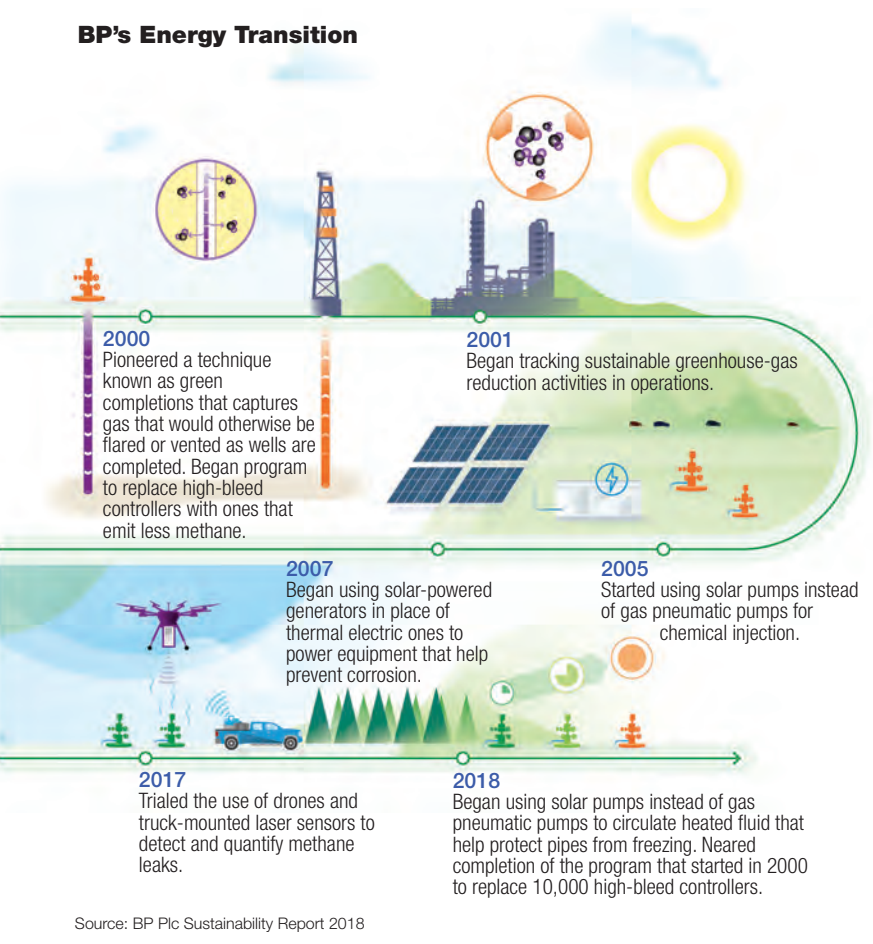
Darren Barbee can be reached at dbarbee@hartenergy.com.
Recommended Reading
BP Restructures, Reduces Executive Team to 10
2024-04-18 - BP said the organizational changes will reduce duplication and reporting line complexity.
Matador Resources Announces Quarterly Cash Dividend
2024-04-18 - Matador Resources’ dividend is payable on June 7 to shareholders of record by May 17.
EQT Declares Quarterly Dividend
2024-04-18 - EQT Corp.’s dividend is payable June 1 to shareholders of record by May 8.
Daniel Berenbaum Joins Bloom Energy as CFO
2024-04-17 - Berenbaum succeeds CFO Greg Cameron, who is staying with Bloom until mid-May to facilitate the transition.
Equinor Releases Overview of Share Buyback Program
2024-04-17 - Equinor said the maximum shares to be repurchased is 16.8 million, of which up to 7.4 million shares can be acquired until May 15 and up to 9.4 million shares until Jan. 15, 2025 — the program’s end date.






